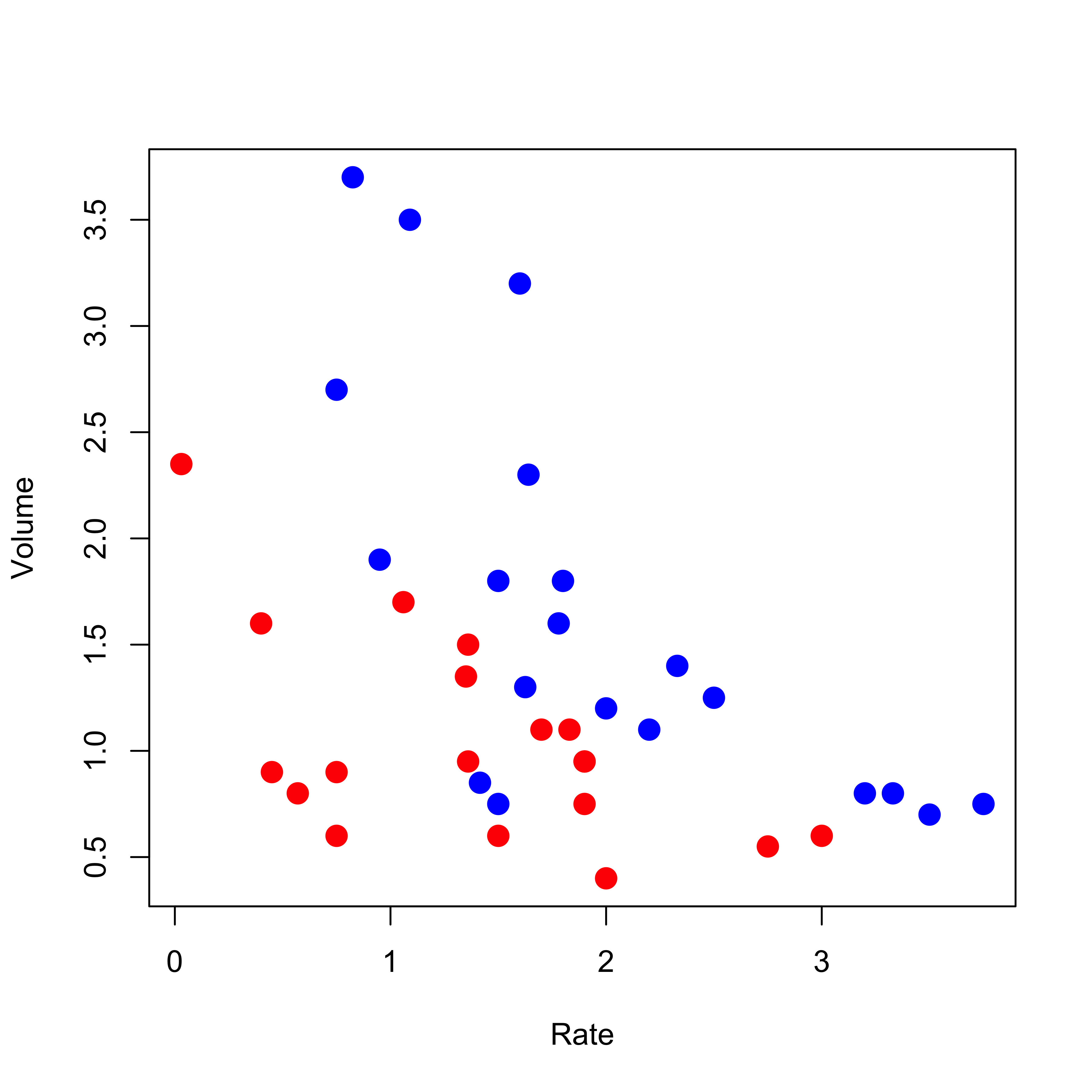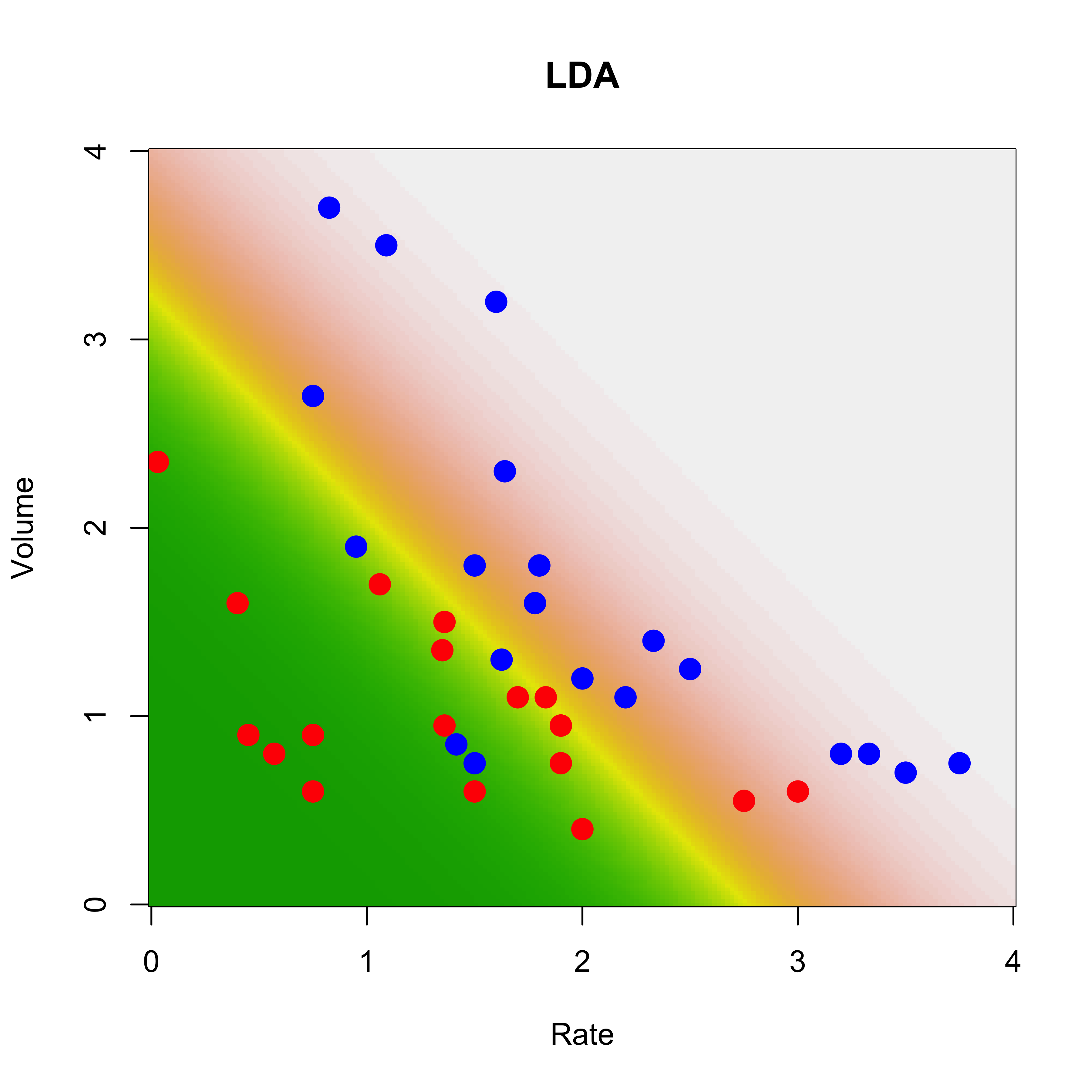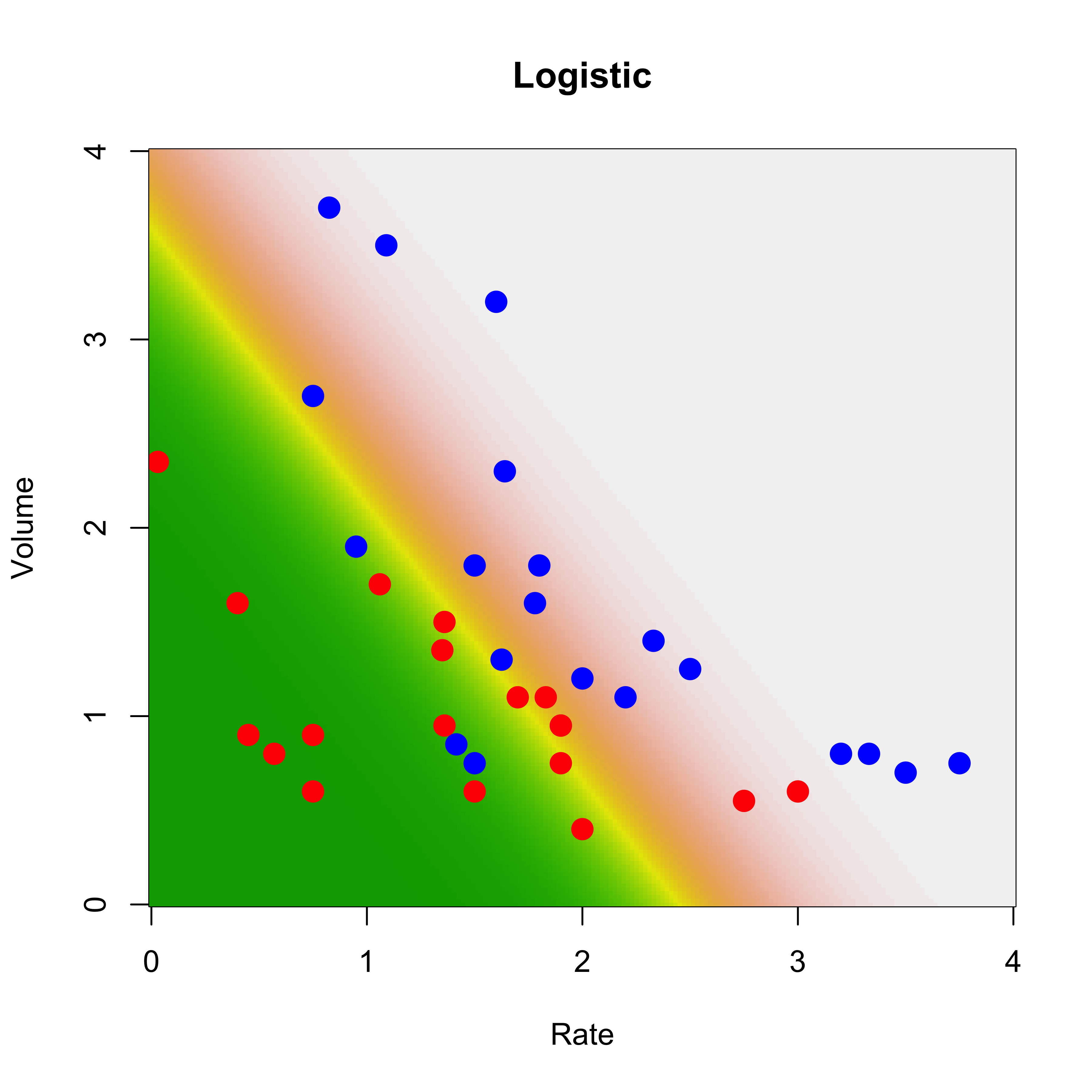data(vaso, package = "robustbase")
plot(Volume ~ Rate,
data = vaso, pch = 19, cex = 1.5,
col = c("red", "blue")[Y + 1]
)
As we discussed in class, what is commonly referred to as classification can be thought of as prediction, when the responses are classes and we use a particular loss function (the 0-1 loss we discussed in class). Furthermore, it is easy to show (which we did in class) that the optimal classifier (in terms of minimizing the expected misclassification error) is the one that assigns an observation to the class with the highest probability of occuring, conditional to the value of the observed explanatory variables.
Most (if not all) classification methods we will cover in this course can be simply thought of as different approaches to estimate the conditional probability of each class, conditional on the value of the explanatory variables. In symbols: P( G = g | X = x_0). The obvious parallel with what we have done before in this class, is that many (all?) regression methods we discussed in class are different ways of estimating the conditional mean of the response variable (conditional on the value of the explanatory variables). Here we are in fact estimating the whole conditional distribution of G given X = x_0; in symbols: G | X = x_0.
As in the regression case, there are different ways to estimate this optimal predictor / classifier. Some will be model-based, some will be non-parametric in nature. And some can be considered “restricted” non-parametric methods (without relying on a model, but imposing some other type of constrain on the shape of the classifier). The equivalent methods for regression with continuous responses are: linear or non-linear regression as model-based methods; kernel or local regression as non-parametric methods; and splines or regression trees as “constrained” (regularized?) non-parametric methods.
Below we first discuss model-based methods (Linear / Quadratic Discriminant Analysis and logistic regression). non-parametric methods (nearest-neighbours and classification trees) will be discussed later.
Probably the “second easiest approach”to estimate the above probability (what would be the easiest one?) is to model the distribution of the explanatory variables within each class (that is, to model the distribution of X | G = g for each possible class g). These conditional distributions will then uniquely determine the probabilities we need to estimate, as discussed above and in class. In particular, one the simplest models we can use for X | G = g is a Normal (Gaussian) multivariate distribution. As we saw in class, if we assume that the distribution of the features for each class is Gaussian with a common covariance matrix across clases, then it easy to show (and I strongly suggest that you do it) that the optimal classifier (using the 0-1 loss function mentioned above) is a linear function of the explanatory variables. The coefficients of this linear function depend on the parameters of the assumed Gaussian distributions, which can be estimated using MLE on the training set. Plugging these parameter estimates in P( G = g | X) provides a natural estimator of each of these conditional probabilities, and thus we can compute an approximation to the optimal classifier.
The function lda in the MASS library implements this simple classifier. We illustrate it here on the rather simple and well-known vaso constriction data, available in the robustbase package. More details, as usual, can be found on its help page. The response variable takes two values (represented below as blue and red), and there are only two explanatory variables (which allows us to visualize our methods and results).
data(vaso, package = "robustbase")
plot(Volume ~ Rate,
data = vaso, pch = 19, cex = 1.5,
col = c("red", "blue")[Y + 1]
)
To train the LDA classifier we use the function lda as follows (note the model-like syntax to indicate the response and explanatory variables):
library(MASS)
a.lda <- lda(Y ~ Volume + Rate, data = vaso)Now, given any value of the explanatory variables (Volume, Rate) we can use the method predict on the object returned by lda() to estimate the conditional probabilities of blue and red.
To visualize which regions of the feature space will be predicted to contain blue points (and then obviously which areas will be predicted to correspond to red responses) we will construct a relatively fine 2-dimensional grid of posible values of the explanatory variables ((Volume, Rate)):
xvol <- seq(0, 4, length = 200)
xrat <- seq(0, 4, length = 200)
the.grid <- expand.grid(xvol, xrat)
names(the.grid) <- c("Volume", "Rate")and estimate the probabilities of the 2 classes for each point in this grid:
pr.lda <- predict(a.lda, newdata = the.grid)$posteriorFinally, we plot the corresponding “surface” of predictions for one class (i.e. the conditional probabilites for that class as a function of the explanatory variables):
image(xrat, xvol, matrix(pr.lda[, 2], 200, 200),
col = terrain.colors(100),
ylab = "Volume", xlab = "Rate", main = "LDA"
)
points(Volume ~ Rate,
data = vaso, pch = 19, cex = 1.5,
col = c("red", "blue")[Y + 1]
)
On the plot above higher numbers are shown with lighther colors (dark green corresponds to very low conditional probabilities).
This model-based approach to classification (LDA) is optimal if the model is correct. The strongest assumption of this model is, of course, the Gaussian conditional distribution of the vector of explanatory variables: X | G = g has a N( mu, Sigma) distribution. The second strongest assumption is that of equal “shape” (in other words, that the covariance matrix Sigma above does not depend on g). This latter assumption can be relaxed slightly if we assume instead that the features have a Gaussian distribution within each class, but that the covariance matrix may be different across classes. In symbols, if we assume that X | G = g has a N( mu, Sigma_g) distribution. The corresponding optimal classifier is now a quadratic function of the predictors (prove it!). The function qda in the MASS library implements this classifier, and it can be used just like lda (as usual, refer to its help page for details).
This approach can be used with any number of classes. Can you think of any limitations?
If we model the distribution of the features within each class using a multivariate Gaussian distribution, then it is easy to see that the boundaries between classes are linear functions of the features (verify this!) Furthermore, the log of the odds ratio between classes is a linear function. It is interesting to note that one can start with this last assumption (instead of the full Gaussian model) and arrive at a fully parametric model for the conditional distibution of the classes given the features (see the class slides). The parameters can be estimated using maximum likelihood. For two classes this is the logistic regression model, which you may have seen in previous courses.
We illustrate this on the vaso data as before. Since this is a 2-class problem, we just need to fit a logistic regression model. The function glm in R does it for us, we specify that we want to fit such a model using the argument family=binomial. Once we obtain parameter estimators (in the glm object a below), we use the predict method to obtain predicted conditional probabilities on the same grid we used before:
a <- glm(Y ~ ., data = vaso, family = binomial)
pr <- predict(a, newdata = the.grid, type = "response")We now plot the data and the surface of predicted probabilities for blue points (higher probabilites are displayed with lighter colors).
image(xrat, xvol, matrix(pr, 200, 200),
col = terrain.colors(100),
ylab = "Volume", xlab = "Rate", main = "Logistic"
)
points(Volume ~ Rate,
data = vaso, pch = 19, cex = 1.5,
col = c("red", "blue")[Y + 1]
)